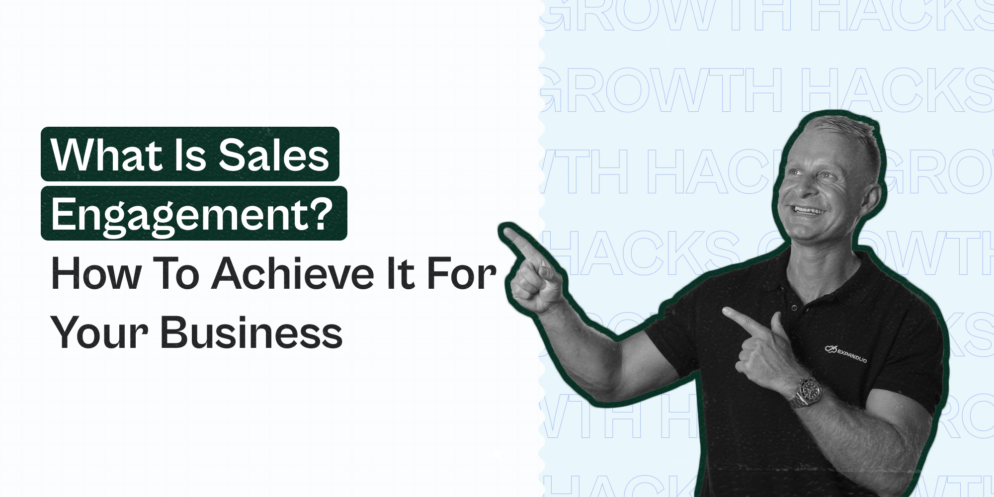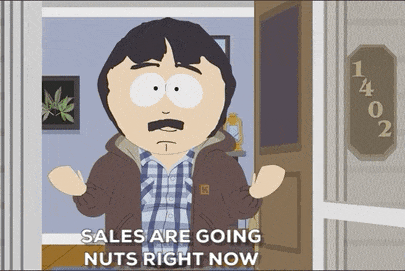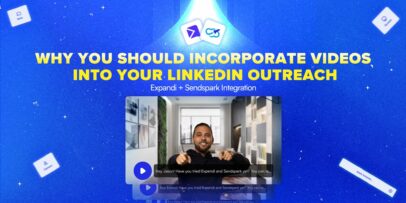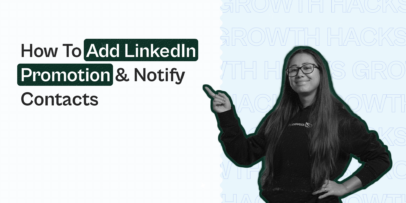What is Sales Engagement & How to Achieve It – Expandi

If you’re doing sales outreach of any kind, chances are you’ve heard the term sales engagement before.
Probably in the context of LinkedIn outreach or during the sales process of your sales organization.
But sales engagement is an exciting concept. Because buyer behavior has gone through a dramatic shift in the last few years
Standing out in a clustered digital sales landscape is challenging.
Business owners are being targeted by salespeople on auto-pilot nowadays.
Receiving probably up to 100 emails, LinkedIn messages and InMails, connection requests, and more. In an attempt to pitch and sell them something.
Now, granted, a lot of automated outreach is spam, which almost never works.
So, if you’re wondering how your sales reps can cut through the noise, stand out, and drive impactful engagement, proper sales engagement is exactly what you need.
Done right, an effective sales engagement campaign will ensure your sales team is targeting the right people, know how to reach them, and how to sell without jumping into a pitch within the first message.
And below, we’ll show you all the latest best practices, sales engagement technology, platforms, campaign examples, and more!
Here’s what we’ll cover:
- What Is Sales Engagement? Platforms and Technology Overview
- Top 3 Sales Engagement Strategy and Outreach Campaign Examples
- Sales Engagement Top 5 Best Practices

But before we get started…
Are you in our private Facebook group yet?
In the LinkedIn Outreach Family, we’re constantly covering the latest sales engagement tips, case studies, and more. Down to the exact sales outreach templates used. Be sure to join and say hi!
What Is Sales Engagement? Platforms and Technology Overview
Sales engagement is a hot topic in the context of sales technology and outreach marketing.
That is why everyone has a different definition, depending on who you ask.
So if you’ve seen the term used as a buzzword in different contexts, that’s why.
But to break it down to its core definition, the answer to the question “what is sales engagement?” is as follows:
Sales engagement is the sequence of interactions between a sales rep and a prospect throughout the sales cycle to move them one step closer to becoming a customer.
This interaction includes sales outreach, LinkedIn engagement, cold calling and emailing, or any other sales touchpoint to take the prospect one step closer to becoming a client.
According to Truelist, it takes around 8 touchpoints to close a sale, and around 60% of customers say “no” before saying “yes.”
During which, you’re also focusing on relationship building.
That is also why sales engagement has developed and transformed into what it is today.
Nowadays, as an example, a proper sales engagement campaign for a sales team may include any of the following steps:
- Sending a LinkedIn connection request.
- Following up on email.
- Sending a LinkedIn message if they accepted the request.
- Sending a LinkedIn InMail if they have not.
- Then, depending on the lead or the campaign’s object, the engagement campaign may jump into asking lead qualification questions and then acting accordingly.
And to save a lot of time doing all this manually, most of these steps can be automated with many marketing and tech tools.

Yes, LinkedIn tools are stronger than ever now.
But we’ll get into the practical steps of a sales engagement outreach campaign in more detail below.
First, let’s discuss what platforms are ideal for sales engagement and the tech and benefits of all this.
What is a sales engagement platform?
Sales engagement platforms are a key component in outreach marketing.
That is to say; you’re going to need to know where your target audience hangs out if you want to reach them for sales engagement.
Make sense, right?
For many B2B, software, marketing, and other online brands, LinkedIn remains the #1 go-to platform to find business CEOs, owners, and more.
Of course, this is if you’re focusing on outreach marketing.
Other prospecting methods (such as content creation) focus on getting the lead to come to you instead.
But for the most part, finding the right sales engagement platform is easier than you’d think.
If you’re looking for an even more specific target audience, you can use LinkedIn Sales Navigator for advanced lead generation filters.
Though, for most of your sales reps, the default and free LinkedIn filters should do the trick just as well.

Now, assuming we’re reaching out to the head of business development executives and sales leaders within Australia, like the above example, as you can see, LinkedIn suggests 150+ leads that fit that criterion.
With the right sales engagement tech stack, you can automate tasks like connecting on LinkedIn, finding their email address, sending follow-up messages, and more.
Now we can finally cover some sales engagement technology that makes all this possible.
How does sales engagement technology and software work?
There are many sales engagement tech, and tools sales reps use daily.
From finding someone’s email address to reaching out so their leads in an omnichannel customer experience, there’s no doubt that sales tools are getting more and more powerful nowadays.
And for the most part, the goal of sales engagement technology is to make the life of sales leaders easier and more convenient.
So, instead of manually writing up the same LinkedIn follow-up messages and templates for a specific segment of your leads, you can fully automate this.
Without overcomplicating this step of sales engagement, here is a list of our favorite sales tools to get you started with outreach.
Note: These are tools we use ourselves and have worked for us successfully.
-
- Expandi – For automated LinkedIn and email outreach campaigns.
- Hyperise – For creating hyper-personalized GIFs and images for your sales outreach.
- Zapier – For connecting your apps and automating your workflow. For example, to alert you on Slack whenever you get a reply from a lead on email.
- Sales CRM – To update lead and client info. Depending on your outreach, you’ll want to integrate this with your sales tools with Zapier.
- Other – This step is optional, but some other tech you can use include Email verification tools, Zoom, Calendly, an email marketing tool, etc.
To get started with sales engagement, you’ll want to focus first on outreach tools.
Everything else you’ll figure out as you go, depending on your requirements and what else can be automated.
So, to recap this step, most sales engagement software should allow you to:
- Automate communication and outreach.
- Organize your conversations in an easy-to-understand dashboard.
- Help you sell smarter.
- Keep track of your marketing KPIs and results.
- A/B test your communication messages and more.
If we combine everything we’ve covered so far (sales engagement platforms and tech stack), here are some of the many benefits you’ll uncover with sales engagement.
Sales engagement benefits
You probably understand how robust sales engagement software can benefit you by now.
So, let’s briefly go over some other underrated sales engagement benefits before we cover the campaign examples and best practices.
1. Increased productivity
Did you know that sales reps spend less than 36% of their time selling?
That’s because they’re spending a lot of their time on administrative tasks like scheduling their calendars, sending emails, updating CRM data, etc.
Traditionally, all these sales tasks have been an essential part of the job.
But now, sales engagement software allows sales teams to do all this with just 1 or 2 clicks.
Automating communication leads to working on more productive tasks with the extra time they gain.
2. More data to make better decisions
Data is the lifeblood of modern businesses and sales in general.
Without it, it’s tough to sell as you don’t know what works and what doesn’t.
Fortunately, most sales engagement tools track sales KPIs like email open rates, reply rates, booking rates, etc.
Sales reps can then make more informed decisions based on the sales engagement results and data.
For example:
- If your sales team has a low open rate, you’ll want to experiment with better outreach subject lines.
- If your sales team has a low reply rate, it’s probably your sales pitch angle or call-to-action.
- If your sales team has a low meeting booked rate, you should consider changing your offer or the audience you’re reaching out to.
And the best part is that you can make these decisions at a glance as all the data is available in the sales software dashboard.
Something like this:

3. Personalization
Finally, another essential part of sales engagement and outreach, in general, has to do with personalization.
As mentioned above, business owners get up to 100+ sales messages per day.
If you want to stand out, you need to show what makes your cold message different.
And for that, we always recommend personalizing your sales messages.
Before, sales reps spent hours writing that perfect personalized first line to show the sales message was authentic and written specifically for the lead.
They would look into the prospect’s podcast, LinkedIn posts, “about us” pages, and more, to show they’ve done the research.
But what does this have to do with sales engagement benefits?
Now, this too can be automated with the right sales software.
For example, the personalization lines below were written by an AI. Then, we simply plugged this sheet into our sales engagement campaign with a custom personalization tag.

The results?
We managed to book 14 calls that week through automated sales outreach!
For more info on that and the whole campaign breakdown (down to the sales tools used and our templates), see the complete guide on LinkedIn InMail outreach.
More on this campaign is below. Keep reading!
Now that you have a better understanding of how sales engagement works let’s look at some sales campaign examples to see what all this put together looks like in practice.
Top 3 Sales Engagement Strategy and Outreach Campaign Examples
Below, we’ll feature some of our top sales engagement and outreach campaigns we’ve covered in our blog.
For simplicity’s sake, we’ll only cover the results and the main steps so that you have an idea or two on how to replicate it.
Though, if you want more info, down to the exact sales templates used, you can check out the entire blog posts in the link.
Now, let’s get started.
1. Hyper-personalized sales engagement campaign with dynamic GIFs

Steps:
- Re-optimized the LinkedIn account for outreach (see our guide on LinkedIn Social Selling Index).
- Created personal, humanizing GIFs for outreach with Hyperise. In this sales engagement campaign, we focused heavily on H2H (human-to-human).
- Filtered our target audience on LinkedIn with Sales Navigator.
- Scraped the list with Expandi and ran an omnichannel outreach campaign – targeting people on LinkedIn and email with personalization and dynamic GIFs.
Results:
- 55% Reply rate.
- Dozens of impressed people who remembered the campaign
For a full breakdown of this sales engagement campaign, see here: The Power Of GIF Animations And Hyper-Personalization In Your LinkedIn Messaging: Skyrocket Your Reply Rate Up to 55%
2. LinkedIn InMail Playbook: 14+ calls per week through automated outreach

Steps:
- Scraped a LinkedIn webinar event with up to 500 attendees.
- Filtered people with an open profile status so that we could send an InMail to.
- Enriched the scraped sheet with Lyne for AI-written personalization lines.
- Used Hyperise to create custom, dynamic GIFs to humanize the sales strategy.
Results:
- 14 calls booked (from 170 people contacted).
- Up to 70% connection request rate.
See here for the exact sales templates and examples: LinkedIn InMails Playbook: How to Book 14 Calls Per Week Through Automated Open InMail Outreach.
3. LinkedIn webinar scraping for sales outreach

Steps:
- Scraped a LinkedIn event relevant to our target audience (marketing webinar with up to 1,000 attendees).
- Included personalization elements about the specific webinar so we didn’t have to spend hours researching each prospect.
- Optional: We know what the target audience is interested in (based on the webinar topic), so we can also mention relevant pain points in the sales outreach. Another bonus tip would be to follow up on email for a true omnichannel sales outreach.
Results:
- 55% acceptance rate.
- 66% reply rate.
This is an effortless sales campaign everyone can pull off. For more info on scraping webinars and the templates we used, see here: How to Scrape LinkedIn Events for Laser-Specific Lead Generation and Outreach To Its Attendees.
Now, finally, before we wrap up, let’s take a look at some of the best practices for sales engagement and using marketing automation software.
Sales Engagement Top 5 Best Practices
1. Always stay up to date
If you want to accelerate your sales engagement process, you need to be always up to date with what’s going on in your industry and your sales platform.
For example, a while ago, LinkedIn changed its algorithm so that you could send only 100 connection requests per week.
And for a while, we were facing the same problem in our sales engagement software.
The new LinkedIn connection limit was becoming a serious problem for sales teams as their primary sales engagement channel had just become considerably harder to use.
But eventually, by being up to date with the latest sales influencers, marketing teams, and industry trends, we found a new way to do sales engagement on LinkedIn.
Essentially, we started from scratch. We re-optimized our LinkedIn accounts and thought of new ways to reach our target audience on LinkedIn. Including:
- Running an open InMail sales campaign to bypass the connection limit.
- Creating a “CSV-import” connector campaign that imports a list of leads as contacts to connect with. (Which is separate from sending them a manual connection request).
- Targeting our leads on email and LinkedIn to create an omnichannel effect.
The latter brings us to our second point.
2. Don’t stick to just one sales engagement channel
Before, many people would specialize in LinkedIn or email outreach.
Nowadays, that’s rare.
Marketing funnel automation is constantly changing, and it’s easier than ever to do outreach now with sophisticated sales tools.
Which is why just about every business owner gets up to 100 cold messages a day.
Now, granted, many of those messages are spam and not even worth reading.
But the point still stands:
You need to cut through the noise if you want to stand out when doing sales engagement.
One of the best ways to do this, in our experience, is to target the leads on multiple sales channels.
That includes:
- LinkedIn.
- Email.
- Retargeting ads.
- Twitter outreach.
- And more.
3. Align sales with marketing
Much of the marketing strategy is typically supported by marketing content and assets.
Be it case studies, testimonials, authority content, or something else.
Your salespeople should use these assets in social media or sales engagement outreach.
Too often, sales and marketing teams don’t get along or are not familiar with what’s going on in the corresponding department.
The easiest way to do this is to set up recurring sprints with the 2 departments. To update on their strategy or operations and if there’s anything, the departments can contribute to each other.
This way, you can learn from the customers’ feedback and adjust sales strategy and content management accordingly.
4. Choose the right sales tools that work for you
If you ask what’s the best sales tools, you’ll probably get a mix of names like Salesforce, HubSpot, DocuSign, and more.
While these are strong sales tools on their own, they’re certainly not for everyone.
It can be straightforward to get overwhelmed by complex sales tools, especially when starting out.
If that’s the case, you should strongly consider searching for alternatives.
Looking into things like:
- Your budget – Many sales tools are for enterprise companies. If that’s beyond your budget range, consider looking for a “startup-friendly” alternative, which there should be plenty of.
- Requirements and features – Many sales tools are jam-packed with features. This may sound nice on paper, but realistically, most sales teams only use around 3-5 main features. And if a tool has too many features to count, it’s probably going to cost more.
Many sales reps use multiple tools. So, consider experimenting with free trials to decide if investing in a tool is worth it.
5. Trust analytics and analyze data
What’s the best way to decide if a sales engagement campaign was a success or a flop?
You look at engagement analytics!
Let’s say your LinkedIn outreach campaign only had a 30% acceptance rate.
If you look at the industry benchmark and average KPIs, you will find out that the number is drastically low.
And it’s a sign you immediately need to A/B test your connection request templates.
The same applies to your reply rates, booking rates, closing rates, etc.
Looking at the back-end data and analytics is one of the best ways to gain actionable knowledge on what to do with your sales campaign.
Hope all the skills we covered above were useful. Make sure you’re not neglecting these steps!
Conclusion
Now, to get you more sales and book more deals, let’s recap:
- How do you drive a sales engagement?
Driving sales engagement involves reaching out to prospects and turning them into engaged customers. To cut a long story short, here are some of the most common steps that drive sales engagement online:
- Sending a LinkedIn connection request.
- Following up on email.
- Sending a LinkedIn message if they accepted the request.
- Sending a LinkedIn InMail if they have not.
- Then, depending on the lead or the campaign’s object, the engagement campaign may jump into asking lead qualification questions and then acting accordingly.
- What is sales engagement technology?
Sales engagement technology is any software that usually makes sales engagement easier to achieve. Typically, this involves LinkedIn automation to save time on manual tasks. Sales engagement technology can also help you:
- Automate communication and outreach.
- Organize all of your conversations and lead info in one easy-to-access dashboard.
- Help you sell smarter.
- Does engagement lead to sales?
Yes, the end goal of sales engagement is to book a meeting with members of your target audience and close the deal. Though, of course, that’s not always the case. So, a better way to put it is that the goal of sales engagement is to take a sales prospect one step closer to becoming a client.
Now, if you’re looking for more info on sales engagement and practical steps to achieve it for your business…
Consider joining our private Facebook group, LinkedIn Outreach Family. We discuss the latest sales strategies, discuss the latest sales strategies, and share more actionable content!
Or, if you’re looking to launch your next sales engagement campaign starting today…
Be sure to sign up for a free Expandi live demo or get started with a free, 7-day trial!
Only the best strategies will bring the best results
New articles straight to your inbox



